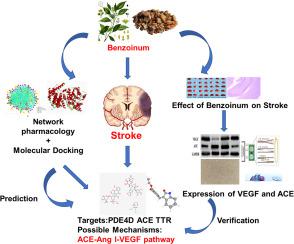Our official English website, www.x-mol.net, welcomes your
feedback! (Note: you will need to create a separate account there.)
Neuroprotection of benzoinum in cerebral ischemia model rats via the ACE-AngI-VEGF pathway
Life Sciences ( IF 5.2 ) Pub Date : 2020-09-12 , DOI: 10.1016/j.lfs.2020.118418 Hai Chen 1 , Mihong Ren 1 , Hongyan Li 1 , Qian Xie 1 , Rong Ma 1 , Yong Li 1 , Xiaoqing Guo 1 , Jian Wang 1 , Daoyin Gong 2 , Tian Gao 2
Life Sciences ( IF 5.2 ) Pub Date : 2020-09-12 , DOI: 10.1016/j.lfs.2020.118418 Hai Chen 1 , Mihong Ren 1 , Hongyan Li 1 , Qian Xie 1 , Rong Ma 1 , Yong Li 1 , Xiaoqing Guo 1 , Jian Wang 1 , Daoyin Gong 2 , Tian Gao 2
Affiliation

|
Stroke is a devastating event with a limited choice of intervention. Benzoinum is frequently used to treat stroke in traditional Chinese medicine. Our team has found that the neuroprotection of benzoinum may related to angiogenesis, but the exact biological mechanism is unclear. The objective of this study was to explore its biological mechanism of angiogenesis in cerebral ischemia model rats. First, network pharmacology and molecular docking were performed to predict the possible targets and mechanisms of benzoinum in treating ischemic stroke. The best dose was then selected according to pharmacodynamic indexes such as those for neurological deficit, cerebral infarction rate, and brain histopathology in middle cerebral artery occlusion (MCAO) model rats. Finally, RT-PCR, Western Blot and immunohistochemical analysis were applied to verify the prediction results from molecular docking. Network pharmacology and molecular docking demonstrated that the targets of treating cerebral ischemia were PDE4D, ACE and TTR, and the mechanism may be related to the ACE-AngI-VEGF signaling pathway. Experimental verification results suggested that 0.50 g/kg and 1.00 g/kg benzoinum could significantly protect against neurological deficit and reduce cerebral infarction rate in the cerebral cortex and hippocampus in MCAO model rats. At an optimal dose, benzoinum could significantly up-regulate VEGF, SHH and ANG-1, yet down-regulate ACE expression in MCAO model rats. Balsamic acid is the active ingredient of benzoinum that protects against ischemic stroke and the possible mechanism is related to the promotion of angiogenesis regulating ACE-AngI-VEGF pathway.
中文翻译:

安息香通过 ACE-AngI-VEGF 通路对脑缺血模型大鼠的神经保护作用
中风是一种破坏性事件,干预措施的选择有限。安息香在中医中经常用于治疗中风。我们团队发现苯偶姻的神经保护作用可能与血管生成有关,但具体的生物学机制尚不清楚。本研究旨在探讨其对脑缺血模型大鼠血管生成的生物学机制。首先,通过网络药理学和分子对接来预测苯偶姻治疗缺血性中风的可能靶点和机制。根据大脑中动脉闭塞(MCAO)模型大鼠神经功能缺损、脑梗死发生率、脑组织病理学等药效学指标选择最佳剂量。最后应用RT-PCR、Western Blot和免疫组化分析验证分子对接的预测结果。网络药理学和分子对接表明,治疗脑缺血的靶点是PDE4D、ACE和TTR,其机制可能与ACE-AngI-VEGF信号通路有关。实验验证结果表明,0.50 g/kg和1.00 g/kg安息香对MCAO模型大鼠大脑皮层和海马神经功能缺损具有明显的保护作用,降低脑梗塞发生率。在最佳剂量下,苯偶姻可以显着上调 MCAO 模型大鼠中 VEGF、SHH 和 ANG-1 的表达,同时下调 ACE 的表达。香脂酸是苯偶姻的活性成分,具有预防缺血性中风的作用,其可能的机制与调节ACE-AngI-VEGF通路促进血管生成有关。
更新日期:2020-09-12
中文翻译:

安息香通过 ACE-AngI-VEGF 通路对脑缺血模型大鼠的神经保护作用
中风是一种破坏性事件,干预措施的选择有限。安息香在中医中经常用于治疗中风。我们团队发现苯偶姻的神经保护作用可能与血管生成有关,但具体的生物学机制尚不清楚。本研究旨在探讨其对脑缺血模型大鼠血管生成的生物学机制。首先,通过网络药理学和分子对接来预测苯偶姻治疗缺血性中风的可能靶点和机制。根据大脑中动脉闭塞(MCAO)模型大鼠神经功能缺损、脑梗死发生率、脑组织病理学等药效学指标选择最佳剂量。最后应用RT-PCR、Western Blot和免疫组化分析验证分子对接的预测结果。网络药理学和分子对接表明,治疗脑缺血的靶点是PDE4D、ACE和TTR,其机制可能与ACE-AngI-VEGF信号通路有关。实验验证结果表明,0.50 g/kg和1.00 g/kg安息香对MCAO模型大鼠大脑皮层和海马神经功能缺损具有明显的保护作用,降低脑梗塞发生率。在最佳剂量下,苯偶姻可以显着上调 MCAO 模型大鼠中 VEGF、SHH 和 ANG-1 的表达,同时下调 ACE 的表达。香脂酸是苯偶姻的活性成分,具有预防缺血性中风的作用,其可能的机制与调节ACE-AngI-VEGF通路促进血管生成有关。











































 京公网安备 11010802027423号
京公网安备 11010802027423号